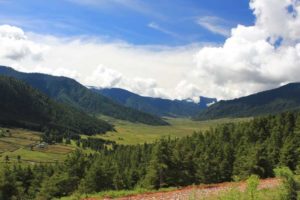Phobjikha is a vast U-shaped glacial valley at an elevation of about 3,000 meters (9,800 ft) and it is a winter home for endangered Black Necked Crane from November to March and migrates back to Tibet by the beginning of spring season. Researchers have confirmed that the same birds which migrates here in winter goes as far back as Mongolia in summer. Every year on the 11th of November, Black Necked Crane Festival is held to celebrate the arrival of this endangered and majestic bird which becomes an inseparable part in the lives of the local people during winter months.
One very famous landmark in this valley is the 17th century Gangtey Monastery popularly know as Gangtey Goenpa (goenpa literally means “remote place” and is usually a place of religious significance). The monastery was founded in 1613 by Pema Thinley, the grandson of Pema Lingpa, the great treasure discoverer from the valley of Bumthang in central Bhutan. The name Gangtey is derived from the fact that the goenpa is built on a peak (tey) of a hillock (gang). Pema Thinley served as the first Gangtey Trulku. The monastery was later expanded by the second Gangtey Trulku Tenzin Legpai Dhendup (1645-1726) and today it is one of the biggest monasteries in Bhutan. The present abbot of this monastery is the ninth Gangtey Trulku His Holiness Kunzang Rigzin Pema Namgyal. The monastery also has a monastic college where hundreds of monks study Buddhist philosophy for 9 years.

